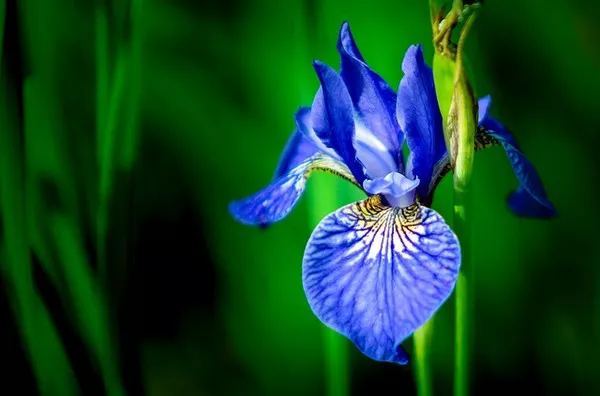Nature’s palette is diverse and vibrant, offering a breathtaking array of colors that delight and inspire. Among the myriad hues found in the natural world, blue holds a special place, evoking feelings of serenity, calmness, and mystery. While blue flowers are relatively rare compared to their more common counterparts, their allure is undeniable. In this article, we delve into the captivating realm of blue flowers, exploring their varieties, symbolism, and the science behind their unique coloration.
The Rarity of Blue Flowers
Blue flowers are a rarity in the plant kingdom, and their scarcity adds to their mystique. While a wide range of flowers come in various shades of red, yellow, and pink, true blue pigments are less common. This scarcity is primarily due to the limited availability of naturally occurring blue pigments in plants. Unlike red, yellow, and orange pigments that are commonly produced by plants, the compounds responsible for producing blue hues are more elusive.
The Science of Blue Pigments in Flowers
The blue coloration of flowers is typically the result of pigments known as anthocyanins. Anthocyanins are water-soluble pigments that can range in color from red to purple to blue, depending on factors such as pH and the presence of co-pigments. These pigments are responsible for the wide range of colors seen in flowers and fruits, playing a crucial role in attracting pollinators and protecting plants from harsh UV radiation.
The production of blue anthocyanins involves a complex biosynthetic pathway. The pigment’s color is influenced by the interaction between anthocyanins and co-pigments such as flavones and flavonols. The presence of metal ions like aluminum in the plant’s tissues can also affect the color produced. These intricate interactions contribute to the final coloration of the flower.
Varieties of Blue Flowers
While blue flowers may be relatively rare, they are by no means absent from the botanical world. Several remarkable species boast stunning blue blossoms that have captured the attention of gardeners, artists, and poets alike. Here are a few notable examples:
Delphinium (Larkspur): Delphiniums are known for their tall spikes of vibrant blue flowers. Their intense blue color adds a striking vertical element to gardens and floral arrangements.
Agapanthus (Lily of the Nile): With their spherical clusters of blue flowers atop long stems, agapanthus brings an exotic touch to landscapes and gardens.
Cornflower (Bachelor’s Button): The delicate, azure petals of the cornflower have made it a beloved wildflower. Its simplicity and beauty have led to its inclusion in gardens and bouquets around the world.
Blue Hydrangea: While the color of hydrangea flowers can vary depending on soil pH, the blue hydrangea is a sought-after variety that adds a cool, calming touch to outdoor spaces.
Morning Glory: The enchanting blue morning glory blooms at dawn, unveiling its trumpet-shaped flowers that fade to a lighter hue as the day progresses.
Blue Iris: The iris family includes several blue-flowering species, each showcasing a unique shade of blue and intricate patterns on their petals.
Gentian: This alpine flower features intense blue blossoms and thrives in cooler climates. Its vivid color is a testament to nature’s ability to produce captivating hues even in challenging environments.
Symbolism of Blue Flowers
The color blue has long been associated with tranquility, depth, and mystery. As a result, blue flowers carry a variety of symbolic meanings across different cultures and contexts. Some common interpretations include:
Calming and Tranquility: Blue is often associated with calmness and serenity. Blue flowers are frequently used to convey a sense of peacefulness and relaxation, making them a popular choice for creating soothing garden spaces.
Hope and Possibility: The color blue can symbolize hope and endless possibilities. In this context, blue flowers may be given as gifts to inspire optimism and a positive outlook.
Remembrance and Sympathy: Blue flowers can also be used to express sympathy and remembrance. They offer a gentle way to convey condolences and honor the memory of a loved one.
Uniqueness and Rarity: The scarcity of blue flowers contributes to their uniqueness, making them a symbol of rarity and distinctiveness.
Cultivating Blue Flowers
Growing blue flowers can present a challenge for gardeners due to the complexities involved in achieving the desired hue. The soil’s pH plays a crucial role in determining the color of some flowers. For instance, hydrangeas’ color can be manipulated by altering the soil’s acidity. Acidic soil encourages the uptake of aluminum, resulting in blue flowers, while alkaline soil leads to pink flowers.
In addition to soil pH, factors such as light intensity, temperature, and genetics also influence the color of flowers. Hybridization and breeding techniques have been employed to develop new blue-flowering varieties with enhanced pigmentation.
Conclusion
The realm of blue flowers is a captivating corner of the botanical world, where scarcity meets beauty and symbolism. These blooms, though rare, have managed to captivate our imaginations, inspiring artists, gardeners, and enthusiasts for generations. The science behind their coloration only adds to their mystique, reminding us of the intricate processes that govern the natural world. Whether adorning gardens, bouquets, or artworks, blue flowers continue to remind us of the enchanting diversity and wonder that nature offers.


